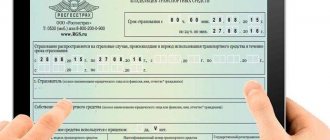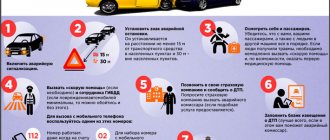If suddenly a traffic inspector stops a car, this causes mental anxiety even among those vehicle owners who have all their documents in absolute order. But, most motorists realize: while the requirement of traffic police officers to show them a driver’s license and papers for vehicle ownership is quite understandable, the requirement to present an insurance policy causes misunderstanding. “Is the driver obligated to present an insurance policy to the traffic police inspector?” — the answer to this question is contained in this article.
When is insurance presented to a traffic police officer?
According to the traffic rules, the insurance protection policy must be presented to the traffic inspector when the obligation under compulsory motor liability insurance is regulated by the Federal Law. A motorist must provide documents for inspection to a traffic police officer in all cases when the inspector legally brakes his car.
During scheduled flights, such a check is not imposed by law, but, understanding the specifics of the traffic police, it is still wiser for motorists to provide documents. For traveling without insurance, a penalty is imposed: there are no objective reasons not to show the policy. Not in all situations the traffic inspector can check the compulsory motor liability insurance. Thus, the question of the necessity/legality of such checks does not lose its relevance today.
When traffic inspectors stop a vehicle to check documents, they are often not asked to provide insurance because they can independently carry out a check using the RSA database.
Is it necessary to show insurance to a traffic cop in Russia in 2021?
Many novice drivers are interested in: do they need to show paper insurance to a traffic cop in Russia? Starting in 2021, the State Duma approved in the first reading a useful bill prohibiting the presentation of regressive compulsory insurance requirements to pedestrians who are at fault for road accidents in which they were injured.
This bill equalizes the importance of electronic/paper policies: they will be considered a single type of compulsory motor liability insurance. Then, to the question: “Is the driver obliged to present insurance to the traffic police inspector in a paper version?”, the answer will be negative. The only thing that motorists will need to present to traffic cops is the number code of the MTPL policy.
Attention! If such an initiative is approved, then all compulsory insurance (paper/electronic format) will receive a unique number code. Using this code, traffic cops will check for the presence of a document: drivers in Russia will have to show the OSAGO number on the phone screen, or dictate it. The inspector will only have to “check” the insurance through the electronic database.
If the amendments are adopted, the inspector will not be able to require the provision of paper insurance, and insurance companies will be able to significantly save on purchasing from the State Insurance Company. sign" of expensive strict reporting forms equipped with special protection. At the same time, the legal norm that allows you to obtain insurance from an insurance company on company letterhead will remain. This means that an absolute transition to an electronic vehicle license on the territory of the Russian Federation will not happen in the near future.
Article on the topic: OSAGO in different insurance companies in 2021, reviews about insurance
The State Duma adopted the document in the first reading, then the initiative will undergo the main second and third readings. If the initiative is approved, it will only come into force six months after its official publication.
Accordingly, if acceptance happens “without rough edges,” real changes will become noticeable. And, the situation today is such that drivers, while on the road, are required to carry with them either an ordinary paper policy or a printed electronic one.
Electronic insurance OSAGO: how it works and are there any advantages?
Each vehicle owner is obliged to take care of the timely registration of compulsory motor third party liability insurance. The presence of this policy for a road user is regulated by the legislation of the country, which implies liability for the lack of valid insurance through the traffic police: a fine, and in the near future, possible deprivation of a driver’s license for up to 6 months. These measures are designed to ensure parity - a guarantee that the party injured in an accident will receive monetary compensation for the damage incurred, even if the culprit does not have the resources to pay appropriately. On the website polis.online you can find current offers on compulsory motor liability insurance from popular insurance companies.
In light of recent events, obtaining or renewing an insurance document in a timely manner has become a problem. However, the functionality for issuing policies online - via the Internet, without the participation of third parties - came in handy. To do this, just select a service provider, follow simple instructions for providing data, and make a payment. The registered policy will be sent by email, which will confirm the legality of participation in road traffic.
Who might be interested in buying an online electronic MTPL policy for a vehicle:
owners who are away and have transferred the right to drive the vehicle to another person; owners of organizations with a large fleet of equipment; to all those who cannot or do not want to personally contact the insurance office.
There are also hidden advantages to working via the Internet. For example, you can study the offers of more insurance companies without interacting directly with each of them. By conducting a comparative analysis, it is often possible to obtain tangible benefits: an additional discount, more useful and fewer unclaimed contract options. All this will require only a certain amount of time and a device with which it is convenient to work with Internet sites.
It would be useful to say once again: MTPL insurance online, which anyone can buy on the Internet, is identical to that issued by insurance agents. At the same time, by eliminating unnecessary options and working directly with the insurance company, in most cases it is possible to save a lot. It's about benefit in terms of both money and time. The whole procedure takes no more than a few minutes, for which you only need documents and the ability to make a non-cash payment.
As an advertisement
POLIS ONLINE LLC, OGRN 1187847378070. Address: St. Petersburg, Ligovsky Avenue, building 266, letter V.
What documentary package should be provided to traffic police officers upon request in 2021?
The text of the code of laws “on compulsory motor liability insurance” clearly states that every motorist is a person obliged to provide his own insurance in three situations:
- in case of an accident;
- in case of non-compliance with traffic rules;
- when deregistering a car.
Clause 2.1.1. The traffic rules answer the question in the affirmative: does a traffic inspector have the right to carry out an inspection? When carrying out the check, the traffic police officer must: introduce himself, indicate his position, indicate the reason for the braking.
Accordingly, the reciprocal responsibility of the vehicle owner is to provide a documentary package consisting of:
- driver's license;
- documents having registration value;
- insurance policy.
This list is mandatory for all drivers, regardless of the situation. Answering the question: “Does a traffic police officer have the right to demand to see the above papers?”, the answer will be positive. In turn, the driver is obliged to present the MTPL to the traffic inspector. At the same time, the insurance must not be expired, and the driver specified in the policy must be in the driver’s seat.
The legislative framework
The law “On Compulsory Motor Liability Insurance” regulates the entire range of issues regarding compulsory insurance.
Following this law (clause 1, article No. 4), all motorists are required to draw up agreements on compulsory motor liability insurance. Otherwise, the vehicle is considered unsuitable for driving on public roads.
Contents of clause 2.1.1., art. No. 2 of the traffic rules informs the following: when driving a car, the driver is obliged to take with him and also provide the traffic inspector with his insurance. But, at the same time, the traffic inspector must have objective reasons for carrying out an inspection of the person behind the wheel.
Contents of paragraph 106 admin. The traffic police regulations say that such requirements include:
- fact of recording a traffic violation;
- the fact that there are guidelines for a specific vehicle;
- the fact of carrying out specialized actions/operations aimed at preventing road accidents;
- the fact that the driver violated the requirements for safe driving (heavily tinted windows, etc.).
The content of clause 84.13 of the Administrative Regulations of the State Traffic Inspectorate informs that the traffic inspector has every right to slow down the car to audit documents for the ability to drive the vehicle, as well as papers for the car.
You should know! If desired, the traffic police officer can easily find many reasons to check the documentary package: at the same time, the driver cannot refuse.
Is the driver required to show proof of insurance and when?
ATTENTION : Stopping a car by a traffic police inspector or another employee of the Ministry of Internal Affairs is not the most pleasant situation. This may mean the fact of a routine check, and even the drawing up of a protocol in view of a violation of traffic rules.
In what situation is it necessary to present a document from the insurance company?
In accordance with the Federal Law “On Compulsory Motor Liability Insurance”, a traffic police officer has the right to demand from the driver, along with other papers, an insurance policy . But only when drawing up a protocol, which means that on your part there must be an offense committed in an administrative manner.
Also, the Traffic Rules in Article 2, paragraph 2.1.1 insist that the driver, upon the first request of a traffic police officer, must provide an insurance form along with other title documents. Thus, we conclude that an insurance document must be provided in the following situations:
- at the time of drawing up a report on the offense you committed;
- as a result of registration of a traffic accident;
- during scheduled traffic police raids (this is not established by law, but is widely applicable in practice).
If you study the legislation, then wherever there is a mention of a compulsory motor liability insurance policy, we are talking about a form that was drawn up in a clearly established form and directly at the office of the insurance company. But what should owners of an electronic OSAGO policy do? Should I bother printing the document or should the traffic police officer himself find the insurance information using the appropriate databases?
Is it necessary to have an insurance agreement in a car?
Many car enthusiasts are interested in: “Is it the responsibility of the autopilot to monitor the presence of the MTPL policy in their car?” The traffic rules do not regulate the form in which the insurance policy should be stored and provided to traffic police officers. The problem is complicated by the fact that most people apply for compulsory motor liability insurance online, receiving it electronically via computer mail.
Article on the topic: Selection of insurance company OSAGO RSA for PTS
For a deciphering of the requirements of the traffic rules clause 2.1.1., informing about the storage/provision of mandatory insurance coverage to traffic inspectors, you should contact the RSA website, which states the following: store/display insurance for inspection to traffic police officers, should be in paper form.
Attention! The E-OSAGO policy must be printed. The paper equivalent of electronic insurance must mirror the entire information base of its digital original, and all data must be easy to read.
If the driver is not the owner of the car being used, the owner’s electronic insurance is not considered adequate. The owner of the car must draw up a separate agreement on compulsory motor liability insurance, taking into account the entire period of use of the car, otherwise the traffic inspector may impose penalties: on the owner/on the illegal driver.
The following fines are paid:
- for driving without a policy – 500 rubles;
- for failure to issue a policy – 800 rubles;
- for driving a car during a period not specified in the insurance – 500 rubles;
- for a driver who is not listed in the insurance – 800 rubles.
Basic rules of MTPL inspection
The traffic police inspector who stopped the car must take the following actions, according to Pr. No. 185, paragraph 19-20:
- Introduce yourself, indicating your title, position, and full name.
- State the reason/purpose of the stop.
- Show your ID if the driver requests it.
If the stated reason is neither an accident, nor a traffic violation, nor the deregistration of the vehicle, the inspector has no reason to check whether the person driving has compulsory motor liability insurance. For example, when a car slows down with the intention of using the driver as a witness, to assist third-party road users, etc.
When the reason for braking a vehicle coincides with the above reasons, the traffic cop has the right to demand that the driver present a standard insurance policy.
Important information! The Administrative Regulations (clause 53) determine the following: all documents must be accepted without covers/other holding devices. The inspector can take the document and go with it to the patrol car for the purpose of auditing the database.
Possible problems when using an electronic OSAGO policy
Until electronic policies were introduced, any driver had to take with him insurance the size of an A4 sheet, certified by the insurance company. After presenting the insurance, the traffic police inspector checks the insurance for its authenticity, checking the information from the VU.
Attention! Today, all Russians driving are required to have a printout of the electronic policy in order to demonstrate it at the direction of the traffic inspector. If there is no policy (or the term has expired), the traffic cop issues a fine.
“At the dawn” of the creation of services, the procedure for obtaining/using electronic policies was associated with a lot of problems. For example, some insurance companies on their websites offered to buy compulsory motor liability insurance, but at the same time, the services worked with large delays. Many insurance companies deliberately created similar obstacles in the implementation of electronic sales of compulsory motor liability insurance due to the fact that when registering online, it is not possible to sell insurance to the owner of the vehicle, with an increased set of additional options. services.
Related article: Features of MTPL insurance classes and how to check them
Today there is an active fight against fraud in the field of online insurance. The main problems of using E-OSAGO have already been successfully resolved.
This policy has many advantages:
- there is no registration fee;
- is issued in an accessible and prompt manner;
- easy to print.
It is especially convenient to issue an electronic policy for people living at considerable distances from the offices of the insurance company: you just need to look at the “territory” of the insurer’s website and send the required information. When registering for E-MTPL, the previously accumulated bonus-malus coefficient does not go away.
The only difficulty with electronic insurance is that there is no possibility of making adjustments to the insurance contract. It is impossible to add/remove drivers or change passport details via the Internet: to do this you will have to go to the IC office. But there is hope that this problem will be solved in the near future.
The traffic inspector does not want to accept E-OSAGO: what to do?
Many motorists complain: when a printed electronic OSAGO policy is presented to a traffic police inspector, he turns out to accept it.
Helpful information! Today, such insurance is not recognized as an official document, and its printed copy often causes a “fit” of mistrust among traffic cops. In this situation, the motorist must ask the traffic police officer to contact the services of a specialized service.
Audit of electronic insurance does not require much time. If a traffic cop refuses to contact the service, explaining this by lack of access to it, then this is no longer a problem for the person sitting behind the wheel. It is easy to cancel the imposed penalty in the case where the OSAGO number code is actually entered into the register.
How does a traffic police officer check an electronic policy?
The inspection process for electronic insurance is similar to the inspection process for regular standard insurance. If, during an inspection of electronic insurance, the inspector has complaints, he must contact the IMTS or the RSA database: the VIN will be required, as well as the state registration number. vehicle number. In the same way, you can check using the number code on the printout.
How to present an electronic MTPL policy to a traffic police officer
Before the introduction of electronic policies, each driver was required to carry an OSAGO form certified by the insurer on sheet A4. After presentation, the traffic police officer checked the validity of this document and checked it with the information on the driver’s license.
Now drivers are required to carry with them a printout of the electronic MTPL policy or a file with MTPL in electronic form for presentation from the screen of a phone, tablet or any other device. At the request of the traffic police officer, it will be enough to show a printout or photo version. In the absence of compulsory motor liability insurance or its expiration, the inspector may issue a fine in the amount of 800 rubles (removal of license plates and towing of the car were abolished in 2014).
The driver does not hand over the insurance policy: what actions will be taken by the traffic inspector
Insurance issued in accordance with all the rules does not relieve you of the obligation to take it with you when driving a vehicle. Before setting off, all drivers must ensure that they have a set of basic documents, including: papers for the car, for the person driving, and an insurance contract.
Neglect of this requirement entails administrative punishment, including drawing up a protocol on the fact of the offense (clause 2, article No. 12.3 of the Administrative Code). Nowadays, traffic cops cannot use such punitive measures as: evacuation of the vehicle to the impound lot, unscrewing license plates.
Attention! The only method of censure is a fine in the amount of 500 rubles. If there is no insurance for the first time, the traffic police officer may limit himself to only a verbal warning.
Often, as a result of an inspection, it is discovered that the car is being driven by a citizen who is not listed in the policy.
In this situation, the traffic cop can impose a fine on both defendants, the driver and the owner of the car:
- for the fact of providing a car to a third party who has no reason to do so - the owner of the vehicle.
- for the fact of lack of necessary insurance papers - to the person driving the car.
Compulsory insurance has been a mandatory element of the basic package of documents for many years: every Russian motorist should have it in their hands. Taking out insurance online can eliminate the burden of printing/storing a copy of E-OSAGO on paper.
Fine for lack of document
As everyone understands, ignorance of the laws does not exempt you from responsibility. The driver’s failure to have a printed policy can result in one of two penalties:
- according to Part 2 of Art. 12.37 Code of Administrative Offenses of the Russian Federation - a fine of 800 rubles. for failure to comply with insurance rules (for the absence of compulsory motor liability insurance at all);
- Part 2 Art. 12.3 of the Code of Administrative Offences—a penalty of 500 rubles. or a warning (with the obligatory issuance of a resolution) for a printout forgotten at home.
When asked whether you need to carry a copy of your MTPL policy with you, the answer is unequivocal - yes, you do. If a motorist cannot confirm the registration of insurance with at least a file saved on a smartphone, by default it is considered that he is guilty under Part 2 of Art. 12.37 Code of Administrative Offenses of the Russian Federation. But he has the right to challenge and re-qualify the punishment under Part 2 of Art. 12.3, if he proves that he had a valid policy at the time of the stop.
It is important to know! In 2021, a system is expected to be put into operation that checks the availability of insurance against the PCA database online using traffic cameras, followed by the distribution of chain letters.
However, the implementation of this project requires combining the RSA and traffic police databases: it is necessary to synchronize data from the AIS with the license plates of the cars that are read by the tracking devices. Most likely, the first test devices will be installed in pilot regions in the fall of 2019.











